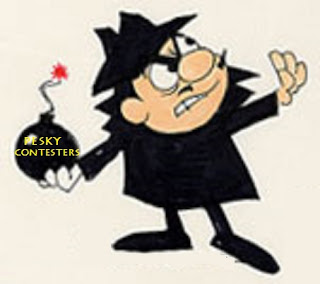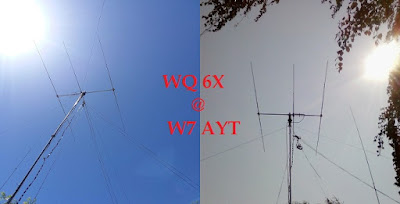This last weekend took advantage of radio/internet technology at all levels; not only in Anza but equally from my portable setup at W7AYT's Concord QTH. Anza being a fully featured SO2-R capable station allowed for 2-separate contest operations (N7NR & VE4EA on Stn-1 and N6KI & WQ6X on Stn-2) to run simultaneously throughout the weekend. Altho there is inter-station chat software between BOTH stations (STN-1 & STN-2), cellphone texting is overall still easier.
Throughout the weekend, I ran several different OP-shifts remotely from STN-2, interspersed with searching & pouncing as WQ6X from Concord; altho on Sunday, WQ6X ran the last 45-minutes calling CQ on 10-meters sweeping the Hy-Gain 3-el Long John 10-m yagi back and forth between Japan and the South Pacific.
While every contest has its difficult moments, world-wide Ssb contests are uniquely challenging
due to what I call the "language barrier". While the English language (assisted by the use of Q-Codes) is considered the de-facto standard on the air (similar to Air Traffic Control), many
OPs know only enough English to only say "FIVE NINE XX". Telling a station they are a DUPE
is usually a waste of time, they probably won't submit a log anyway.
Just in time for Halloween, this weekend brought us a mixture of Strange-QRM (intentional jammers) and Strange-QRN (weird Space-WX). While BOTH the FT-2000 and K3/0 are replete with numerous QRM and QRN filters, what REALLY made the difference was the pair of Autek QF-1A analog audio filters for processing the myriad of different voices - differently for each ear. The Aux. notch filer knob in each unit accomplished what the IF filters built-in to each transceiver could not.
The contest weekend was riddled with Space-WX anomalies, altho the upper bands were
amazingly wide open. Missing here on the west coast were European signals. While the combination of analog/digital filtering helped immensely with the eradication of weird noise
patterns and adjacent-channel QRM, it was virtually helpless in eliminating intentional QRM;
such as non-amateur Chinese/Russian military traffic on 3.749 (@11:48z) and the intentional
bubbly sounds and "PoP" on 28.555 (@22:50z).
This contest brought us a bevy of Tune-Up Turkeys on virtually every band, throughout every day
and evening. The I-F auto-notch in the K-3 and the audio-based auto-notch in the FT-2000 all but eliminated the careless carriers. I also announced (to the "Peanut Gallery") that they were wasting their time for that reason. That was enough to "swat the flies away"; unfortunately, like REAL flies, they came back many times before giving up, putting on their jammies and slinking off to bed.
I have said many times that Ssb contests on 40-meters bring the intentional RTTY-QRM jammers out
of the rafters to exact their revenge against (what they call) "those pesky contesters".
Their favorite time of night is between 09:30z and 11:30z (2:30am to 4:30am)
In addition to the pesky Tune-Up Turkeys, at 11:38z, out of nowhere appeared what I have often termed a "data cranker", while running a frequency on 7.130.
At 20:55z FT8-QRM showed-up and dominated the station running 21.225.
Running the math on this, gives us a 3rd-harmonic from the ubiquitous 7.075 FT8-cluster frequency; the BiG question being whose FT-8 signal this actually was from. It is hardly unheard-of that 3rd-harmonic signals can sometimes be heard quite a distance away from the transmitting location.
At 10:35z N2KI replied to my CQ calls with "QRZ?". HuH? WTF?!!
Later, tuning around 10-meters, a Cw station was encountered on 28425.89 sending seemingly-coherent Cw, but no callsign-ID. While the 8th-harmonic of 3.553 could account for this, except unless it was "next door", it would be extremely weak; additionally, at 22:00z it is unlikely anyone would be running Cw on 80-meters.
At 10:35z N2KI repeatedly replied to my CQ calls with "QRZ?". HuH? WTF?!!
Behind the scenes on 75-meters was an Asian WooDPecker station that centered itself
EXACTLY on top of my 3747.47 run frequency. While moving to far-removed 3766.66 helped out somewhat, the spectrum analyzer waterfall displayed the wide-bandwidth effects of this station. Switching the 4-Square array to N-E, S-E & S-W, everything was quiet; switching the antenna
to N-W brought us the woodpecker assault - FULL-strength.
The last thing I have to say about CQ W.W. contests is that this is the only specifically world-wide
DX contest where Billy-Bob, his brother Barney and all their buddies can call-in for a QSO, altho much of the time they didn't know what a CQ Zone-# is.
When it was all over, it would seem that NX6T took 35th-place overall and 1st-place for Zone-3,
W6 (California) and the Southwest ARRL section. Because most of the WQ6X QSOs were made
on 10-meters, I submitted the log as SOA10m (Single-OP Assisted, 10-meters). Doing so put WQ6X in 2nd-place for Zone-3 and 1st-place for W6 (California) and N/W.
DiD YOU work the CQ World Wide DX contest?
Is WQ6X or NX6T in YOUR Log?



















.Jpg)


.Jpg)













.Jpg)



.Jpg)


